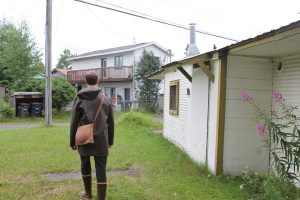Historic buildings crumbling in Anchorage, Alaska face an uncertain future

There’s no placard marking the historical significance of the Government Hill Wireless Station in Anchorage, southern Alaska.
The property played an essential role in Alaska’s history. The Station used to connect Anchorage with the rest of the world. But now, it’s just three dilapidated buildings sitting in an overgrown lot surrounded by suburban homes. Yellow paint peels from around broken and barred windows.
Connor Scher appears from around the corner wearing a wooden bow tie and a rubber rain jacket. He pulls out a drill to open the door of the main building. It’s topped with the original cupola, which once served as a beacon for Anchorage’s port.
“This has sunken through, so don’t step on it,” Scher cautioned as we step inside.
Graffiti covers the walls and bits of glass litter the sunken floor. But there are some reminders of the building’s glory days: like an old telephone and a painted map of Alaska.
For more than three decades, the Station supplied radio communication between Anchorage and the outside world. Station employees radioed Nome (western Alaska) during the winter of 1925 to tell the community life-saving serum was on its way, a trip that later inspired the Iditarod. And it was instrumental in the construction of Alaska’s railroad.
But now, it’s abandoned.
“I believe it won’t be occupiable within the decade. So there is that, that added impetus to do something,” Scher said.

A little-known piece of history
Scher wrote his master’s thesis on the station. He wanted to memorialize it by telling its story. He started researching the buildings while interning for the city’s historic preservation plan.
“I just continued to get interested and inspired by the story and history that was here and how specifically that no one really remembered it. Outside of the neighborhood, no one has really heard of this structure,” Scher said.
Pushing for restoration
Some residents of the Government Hill neighborhood want to see the buildings restored. Some want the property turned into a tourist destination. And some want it to serve the community in some way, like as a library or housing. That’s what Scher wants too.

“There is a chance for it to serve the neighborhood with an actual use, not just as a spectacle in a field, which too often is the fate of historic buildings,” Scher said.
The federal Alaska Engineering Commission built the first of the three buildings in 1917 to facilitate communication for railroad construction. Scher says the development of the station corresponded with the development of Anchorage.
“This was an arrival of modernization to this frontier,” Scher said. “And this building represented that development.”
In 2015, it was listed on the National Register of Historic Places. The city now owns the property, and last year, they put out a request for proposals for someone to develop it. But no one responded. Dealing with extensive repairs and hazards like asbestos would be pricey.
Until someone foots the bill, an important piece of Alaska’s telecommunications history will continue to crumble.
Related stories from around the North:
Canada: Canada wants to list mysterious Arctic petroglyphs as UNESCO World Heritage Site, Radio Canada International
Finland: Archaeological sites targeted in Finland, Yle News
Norway: Roald Amundsen’s Maud back home 100 years after setting sail from Norway, CBC News
Russia: Abandoned Russian airbase to become wealthy residential neighborhood, Photo report by The Independent Barents Observer
United States: Alaskan historical site, birthplace of state flag, remains a ruin despite investments, Alaska Public Media



